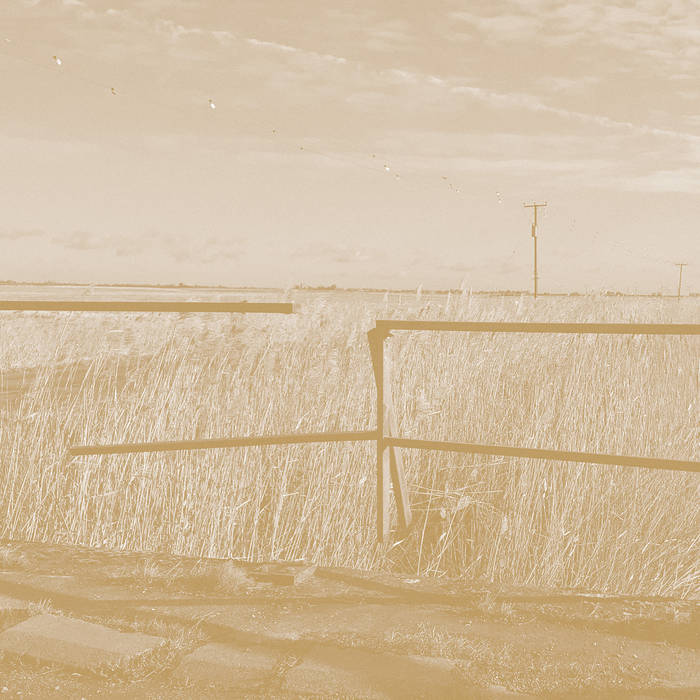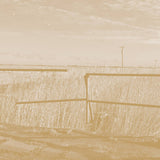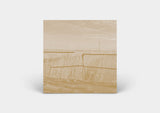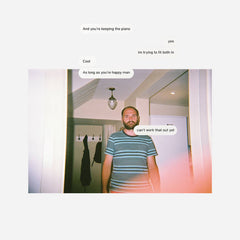Simon Scott // Long Drove CD
- Availability:
イギリスのアンビエント作家Simon Scott (Slowdiveのドラマー)が、2022年12月にオーストラリアの実験レーベルRoom40からリリースした最新作です。
冬の日差しのように柔らかいアンビエント6曲を収録。シュリンク仕様です。
以下、レーベルと作家による解説です。
スコットがRoom40のために書いた最初のエディションのタイトルである「Long Drove」は、イギリスの作曲家、マルチインストゥルメンタリスト、マスタリングエンジニアのサイモン・スコットの自宅に近い場所フェンズについてです。そこはホルムフェンとニューデコイと呼ばれる2つの自然保護区を結ぶ連絡通路で、両地域はグレートフェンプロジェクトと呼ばれる生息地復元プロジェクトの一部であり、スコットが幼少期に育った場所にも近いです。この地域は、10年以上前にスコットが12kで「Below Sea Level」(後にTouchで再発売)を制作した際に、初めて作曲のインスピレーションを得る場所となりました。フェンズに戻った彼は、この「Long Drove」で紹介されている、場所と田舎のトラウマに関する親密な音の物語である、いくつかの新作を生み出しました。
フェンズの近未来は、さらなる地盤沈下と洪水の脅威が懸念され、依然として明白な懸念事項となっています。フィールド・レコーディングは、朽ち果てたテープ・ループとデジタル処理されたフェンランドの音のテクスチャーのメランコリックな洗浄によって消滅し、展開されるため、気候変動の結果、元の湿地に戻り、再び水没したらフェンスはどのように聞こえるだろうかというスコットの思考過程がこの5曲から聞こえてきそうです。
「私は定期的に、人里離れた名もない壊れた橋を訪れます。この橋は、ホルムフェンとニューデコイ自然保護区を結ぶ長い排水溝の上にあり、単に耳を傾けるためだけのものです。季節が変わるたびに、野生動物の鳴き声が、広くて平らなフェンズに張り巡らされた長い電線の音と融合し、合体するのを観察しに戻ってきました。私は同じ場所でも異なる音の特徴を感じ取り、すぐにその広大なポリフォニックな栄光を録音し始めました。偶然にも、私の水筒が鉄橋に当たり、フェンスの風景に銅鑼のような音が響いたのです。これをきっかけに、私はソフトマレットを使って実際に橋をパーカッシブな楽器として演奏し、その響きをとらえることにしました。その後、橋の垂直開口部のひとつに小さなDPAマイクを設置し、金属製の橋の内側と外側にある多くの音波のフィルターとして機能させたいと思うようになりました。橋のどの部分を叩くか、どの季節に叩くかによって、橋の振動的な音質が違ってくるのです。
Holme Fen Posts は、イングランドで最も低い地図上の位置(平均海面から6フィート)にある有名な鋼鉄製のホルム・フェン自然保護区の支柱2本のうちの1本から採取したループ状の録音をトレースしたものです。この支柱は、1851年に地元の地主であるウィリアム・ウェルズによって、地盤沈下の測定値を得るために地面に打ち込まれました。柱には、その後の地盤沈下の日付を示す金属製のプラカードが取り付けられており、スコットはその音波を捉えるために2本のコンタクトマイクを水平な柱の間に挟み込みました。録音された音は、鉄の彫刻のゆっくりとした深い振動音だけでなく、スコットが録音したときに発生した土砂降りなどの自然現象や、周囲の共鳴が生み出すリズミカルなダイナミクスを明らかにしています。
風という自然現象は、『The Whistling Wire』で聴かれるようなエオリアン的な音の特徴となり、橋が叩かれる柔らかいリズムは、その振動が生み出す長音のドローンや残響質となって、フェンズの複雑な音の地形を現すのです。人為的な介入なしにワイヤーの穴に点火する風のシンフォニックな栄光をとらえること。これは、気候変動によって引き起こされた伝達可能な音楽性の移り変わりを誘発するものです。The Black Fenは、エオリアンフィールドレコーディングのカセットテープのループによって音場をトレースし、スコットのモジュラーシンセシステムに入力すると操作され、徐々に隠れたメロディーを引き出していきます。
レーベルその他作品はこちら /// Click here to see more Room40 releases available at Tobira.
----------------------------
Matte laminate, monochromatic printed and embossed sleeve + insert card.
Room40:
"‘Long Drove’, the title of Scott’s first edition for Room40, is a location in the Fens close to the home of British composer, multi-instrumentalist and mastering engineer Simon Scott. It is the connective pathway between two nature reserves, called Holme Fen and New Decoy, and both sites are part of a habit restoration project called The Great Fen Project and is close to where Scott grew up as a child. This area first became a location of compositional inspiration over a decade ago, when Scott created 'Below Sea Level' on 12k (later reissued on Touch). His return to the Fens has produced a number of new works, presented here on ‘Long Drove’, that are intimate sonic narratives of place and rural trauma.
‘Long Drove’ is a site-specific sound study which shifts the Anthropocene discourse from spectatorship to musical participation, accountability, and creative engagement. The near future of the Fens, with concerns of further subsidence and threat of flooding, remains a palpable concern. One can almost hear Scott’s thought processes within these five compositions, of what the Fens would sound like if submerged and flooded by water again, returning to its original marshland state as a result of climate change, as the field recordings dissipate and unfurl with melancholic washes of decaying tape loops and digitally processed textures of Fenland sonorities.
“I regularly visit the remote and nameless broken bridge,” Simon explains, “that is situated over a long drainage ditch that connects Holme Fen and New Decoy nature reserves, simply to listen. Each season I’d return to observe the sonorities of wildlife merge and coalesce with the hum of the long telephone wires that stretch across the wide and flat Fens. Within my audition I’d perceive different sonic characteristics within the same location and I soon began to record its vast polyphonic glory. By pure serendipity my water bottle accidentally struck the steel bridge, and it rang out like a gong across the Fen landscape. This inspired me to use soft mallet beaters to actually play the bridge as a percussive musical instrument and capture its resonant qualities. A subsequent desire was also to place my tiny DPA microphones inside one of the bridge vertical openings to act as a filter of the many sonorities within and outside of the metal bridge. The vibratory aural qualities of the bridge would differ depending on what part of the bridge I struck and what season it was.”
‘Holme Fen Posts' traces out looped recordings taken from one of two of the famous steel Holme Fen nature reserve posts, which are located at the lowest cartographical location in England (six feet below mean sea level). The posts were driven into the ground in 1851 to take ground readings of subsidence by local landowner William Wells. Metal placards were attached to the posts to depict the subsequent dates of the level of the ground and Scott wedged two contact microphones in between the horizontal posts to capture its sonorities. The recordings reveal not only the slow and deep vibratory sounds of the steel sculptures but also the rhythmic dynamics created by natural phenomena, such as the downpour occurring as Scott recorded, and the resonances within the surrounding area.
The natural phenomena of wind became aeolian sound characteristics, as heard in The Whistling Wire, and the soft rhythm of the bridge being struck became the long-pitched drones and reverberant textures that these vibrations produced reveals the complex sonic topography of the Fens. From capturing the symphonic glory of the wind which, without any human intervention, ignites the holes in the wires. This triggers shifting planes of transmissible climate change induced musicality. ‘The Black Fen’ traces sound fields through cassette tape loops of aeolian field recordings which are manipulated when fed into Scott’s modular synth system to gradually tease out submerged hidden melodies. "
Artist : Simon Scott
Label : Room40
イギリスのアンビエント作家Simon Scott (Slowdiveのドラマー)が、2022年12月にオーストラリアの実験レーベルRoom40からリリースした最新作です。
冬の日差しのように柔らかいアンビエント6曲を収録。シュリンク仕様です。
以下、レーベルと作家による解説です。
スコットがRoom40のために書いた最初のエディションのタイトルである「Long Drove」は、イギリスの作曲家、マルチインストゥルメンタリスト、マスタリングエンジニアのサイモン・スコットの自宅に近い場所フェンズについてです。そこはホルムフェンとニューデコイと呼ばれる2つの自然保護区を結ぶ連絡通路で、両地域はグレートフェンプロジェクトと呼ばれる生息地復元プロジェクトの一部であり、スコットが幼少期に育った場所にも近いです。この地域は、10年以上前にスコットが12kで「Below Sea Level」(後にTouchで再発売)を制作した際に、初めて作曲のインスピレーションを得る場所となりました。フェンズに戻った彼は、この「Long Drove」で紹介されている、場所と田舎のトラウマに関する親密な音の物語である、いくつかの新作を生み出しました。
フェンズの近未来は、さらなる地盤沈下と洪水の脅威が懸念され、依然として明白な懸念事項となっています。フィールド・レコーディングは、朽ち果てたテープ・ループとデジタル処理されたフェンランドの音のテクスチャーのメランコリックな洗浄によって消滅し、展開されるため、気候変動の結果、元の湿地に戻り、再び水没したらフェンスはどのように聞こえるだろうかというスコットの思考過程がこの5曲から聞こえてきそうです。
「私は定期的に、人里離れた名もない壊れた橋を訪れます。この橋は、ホルムフェンとニューデコイ自然保護区を結ぶ長い排水溝の上にあり、単に耳を傾けるためだけのものです。季節が変わるたびに、野生動物の鳴き声が、広くて平らなフェンズに張り巡らされた長い電線の音と融合し、合体するのを観察しに戻ってきました。私は同じ場所でも異なる音の特徴を感じ取り、すぐにその広大なポリフォニックな栄光を録音し始めました。偶然にも、私の水筒が鉄橋に当たり、フェンスの風景に銅鑼のような音が響いたのです。これをきっかけに、私はソフトマレットを使って実際に橋をパーカッシブな楽器として演奏し、その響きをとらえることにしました。その後、橋の垂直開口部のひとつに小さなDPAマイクを設置し、金属製の橋の内側と外側にある多くの音波のフィルターとして機能させたいと思うようになりました。橋のどの部分を叩くか、どの季節に叩くかによって、橋の振動的な音質が違ってくるのです。
Holme Fen Posts は、イングランドで最も低い地図上の位置(平均海面から6フィート)にある有名な鋼鉄製のホルム・フェン自然保護区の支柱2本のうちの1本から採取したループ状の録音をトレースしたものです。この支柱は、1851年に地元の地主であるウィリアム・ウェルズによって、地盤沈下の測定値を得るために地面に打ち込まれました。柱には、その後の地盤沈下の日付を示す金属製のプラカードが取り付けられており、スコットはその音波を捉えるために2本のコンタクトマイクを水平な柱の間に挟み込みました。録音された音は、鉄の彫刻のゆっくりとした深い振動音だけでなく、スコットが録音したときに発生した土砂降りなどの自然現象や、周囲の共鳴が生み出すリズミカルなダイナミクスを明らかにしています。
風という自然現象は、『The Whistling Wire』で聴かれるようなエオリアン的な音の特徴となり、橋が叩かれる柔らかいリズムは、その振動が生み出す長音のドローンや残響質となって、フェンズの複雑な音の地形を現すのです。人為的な介入なしにワイヤーの穴に点火する風のシンフォニックな栄光をとらえること。これは、気候変動によって引き起こされた伝達可能な音楽性の移り変わりを誘発するものです。The Black Fenは、エオリアンフィールドレコーディングのカセットテープのループによって音場をトレースし、スコットのモジュラーシンセシステムに入力すると操作され、徐々に隠れたメロディーを引き出していきます。
レーベルその他作品はこちら /// Click here to see more Room40 releases available at Tobira.
----------------------------
Matte laminate, monochromatic printed and embossed sleeve + insert card.
Room40:
"‘Long Drove’, the title of Scott’s first edition for Room40, is a location in the Fens close to the home of British composer, multi-instrumentalist and mastering engineer Simon Scott. It is the connective pathway between two nature reserves, called Holme Fen and New Decoy, and both sites are part of a habit restoration project called The Great Fen Project and is close to where Scott grew up as a child. This area first became a location of compositional inspiration over a decade ago, when Scott created 'Below Sea Level' on 12k (later reissued on Touch). His return to the Fens has produced a number of new works, presented here on ‘Long Drove’, that are intimate sonic narratives of place and rural trauma.
‘Long Drove’ is a site-specific sound study which shifts the Anthropocene discourse from spectatorship to musical participation, accountability, and creative engagement. The near future of the Fens, with concerns of further subsidence and threat of flooding, remains a palpable concern. One can almost hear Scott’s thought processes within these five compositions, of what the Fens would sound like if submerged and flooded by water again, returning to its original marshland state as a result of climate change, as the field recordings dissipate and unfurl with melancholic washes of decaying tape loops and digitally processed textures of Fenland sonorities.
“I regularly visit the remote and nameless broken bridge,” Simon explains, “that is situated over a long drainage ditch that connects Holme Fen and New Decoy nature reserves, simply to listen. Each season I’d return to observe the sonorities of wildlife merge and coalesce with the hum of the long telephone wires that stretch across the wide and flat Fens. Within my audition I’d perceive different sonic characteristics within the same location and I soon began to record its vast polyphonic glory. By pure serendipity my water bottle accidentally struck the steel bridge, and it rang out like a gong across the Fen landscape. This inspired me to use soft mallet beaters to actually play the bridge as a percussive musical instrument and capture its resonant qualities. A subsequent desire was also to place my tiny DPA microphones inside one of the bridge vertical openings to act as a filter of the many sonorities within and outside of the metal bridge. The vibratory aural qualities of the bridge would differ depending on what part of the bridge I struck and what season it was.”
‘Holme Fen Posts' traces out looped recordings taken from one of two of the famous steel Holme Fen nature reserve posts, which are located at the lowest cartographical location in England (six feet below mean sea level). The posts were driven into the ground in 1851 to take ground readings of subsidence by local landowner William Wells. Metal placards were attached to the posts to depict the subsequent dates of the level of the ground and Scott wedged two contact microphones in between the horizontal posts to capture its sonorities. The recordings reveal not only the slow and deep vibratory sounds of the steel sculptures but also the rhythmic dynamics created by natural phenomena, such as the downpour occurring as Scott recorded, and the resonances within the surrounding area.
The natural phenomena of wind became aeolian sound characteristics, as heard in The Whistling Wire, and the soft rhythm of the bridge being struck became the long-pitched drones and reverberant textures that these vibrations produced reveals the complex sonic topography of the Fens. From capturing the symphonic glory of the wind which, without any human intervention, ignites the holes in the wires. This triggers shifting planes of transmissible climate change induced musicality. ‘The Black Fen’ traces sound fields through cassette tape loops of aeolian field recordings which are manipulated when fed into Scott’s modular synth system to gradually tease out submerged hidden melodies. "
Artist : Simon Scott
Label : Room40







![The Black Dog // Loud Ambient LP [COLOR]](http://tobirarecords.com/cdn/shop/files/lou1_a076b831-d37c-4b28-b3c3-22686541921c_medium.jpg?v=1763093295)